Lecture on how to read foreign patent gazettes for beginners
2020.04.01 | search column
table of contents
1. In the beginning
Thanks to the information infrastructure in recent years, it has become easier to obtain foreign literature.For this reason, I think that the number of people who are blessed with the opportunity to read not only Japanese patent gazettes but also foreign patent gazettes (or "opportunities to read") has increased.
On the other hand, I often hear people say that it is difficult to read foreign patent gazettes.Certainly, in foreign patent gazettes, it often happens that you do not know how to read a long sentence written in a foreign language, or you are reading from the beginning of the sentence but you can not find the point and get confused. It's easy.
However, when reading a patent gazette, there should be overwhelmingly more opportunities to "get the information you need" than to "enjoy reading as a reading material."If so, I think that the purpose of "reading the gazette" can be achieved even if it is a foreign patent gazette by grasping the point of "where" the "information you want to know" is "stated".
XNUMX. XNUMX.Basic knowledge for reading foreign patent gazettes
XNUMX-XNUMX Basic structure of patent and publications
A patent is a system with the purpose of "giving an exclusive right to a person who has made an invention that is useful for industry and has patentability for a certain period of time." In order to convince the examiner that it is a "patentable invention", "(XNUMX) used this time" to "(XNUMX) solve" "(XNUMX) some problems / problems" that existed in "(XNUMX) conventional technology". I will develop the theory in the document so that I can understand the flow of "I developed the method".This is basically the same in Japan and other countries.
Therefore, the "contents" written in patent gazettes (public patent gazettes, patent gazettes, etc.) are not so different whether they are Japanese gazettes or foreign gazettes.
Basically, the following contents are included in one gazette.
- Technical field
- Background technology (conventional technology)
- Problems to be solved by the invention
- Means to solve problems
- The invention's effect
- Example
The same is true when reading Japanese gazettes, but when reading foreign gazettes, the above flow is as follows: "(XNUMX) (XNUMX) What are the problems with conventional technology?" "(XNUMX) What method was used this time?" It is basic to understand.To put it the other way around, the reason why foreign publications, which should be the same as Japanese publications in terms of content and development, is difficult to read is that it is difficult to find the description, so this time we will focus on how to find the description.
XNUMX-XNUMX Common structure in foreign publications
Even in foreign publications, in many publications written by Japanese applicants, issues, effects, examples, etc. are organized together with headings, and the structure is easy for the reader to understand.
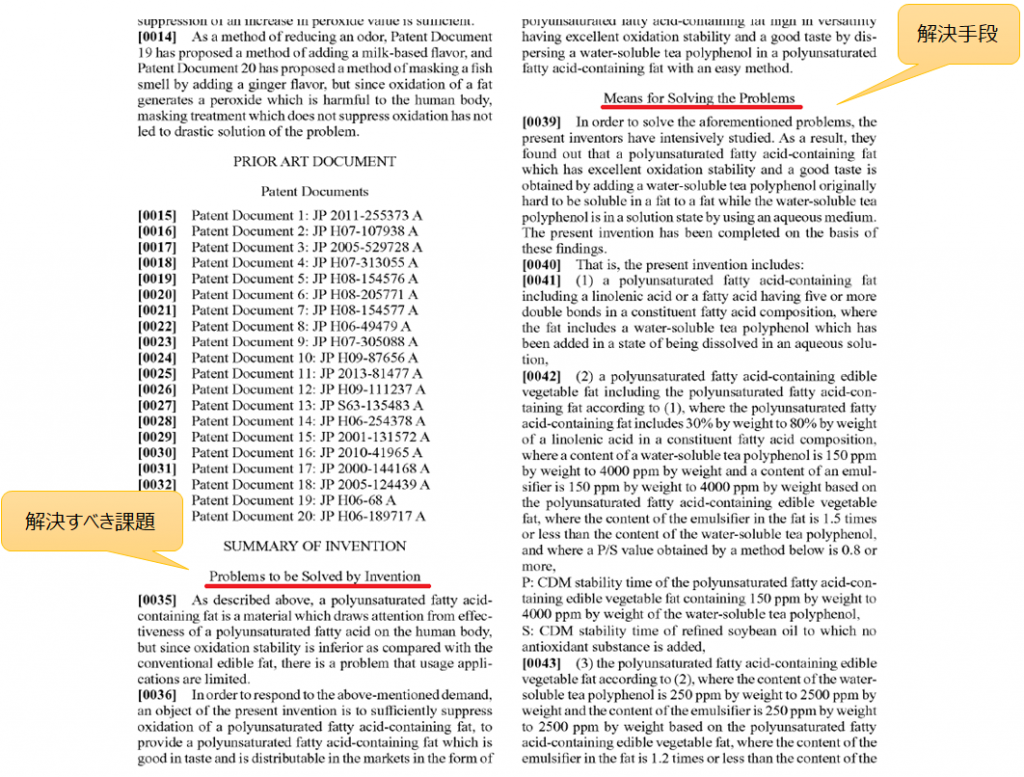
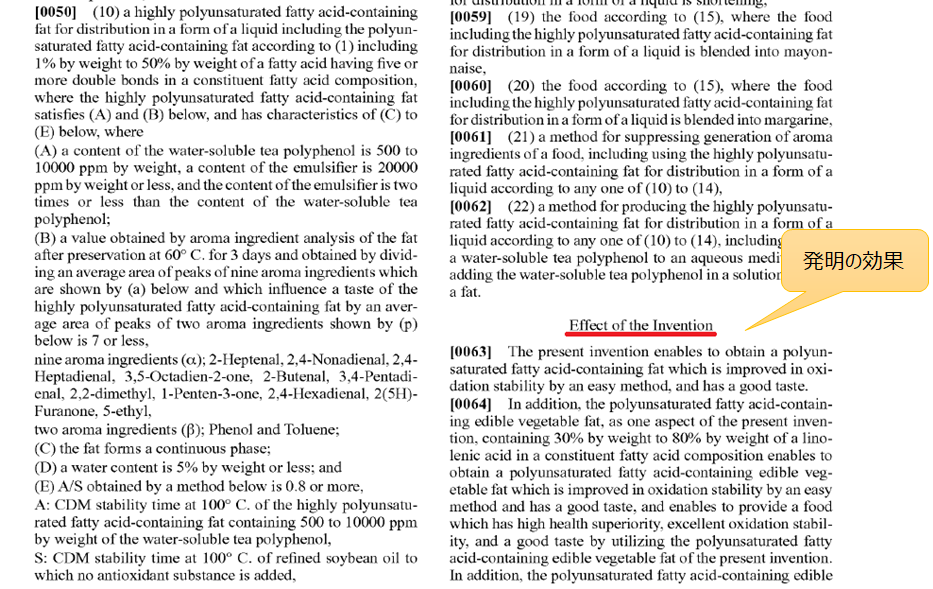
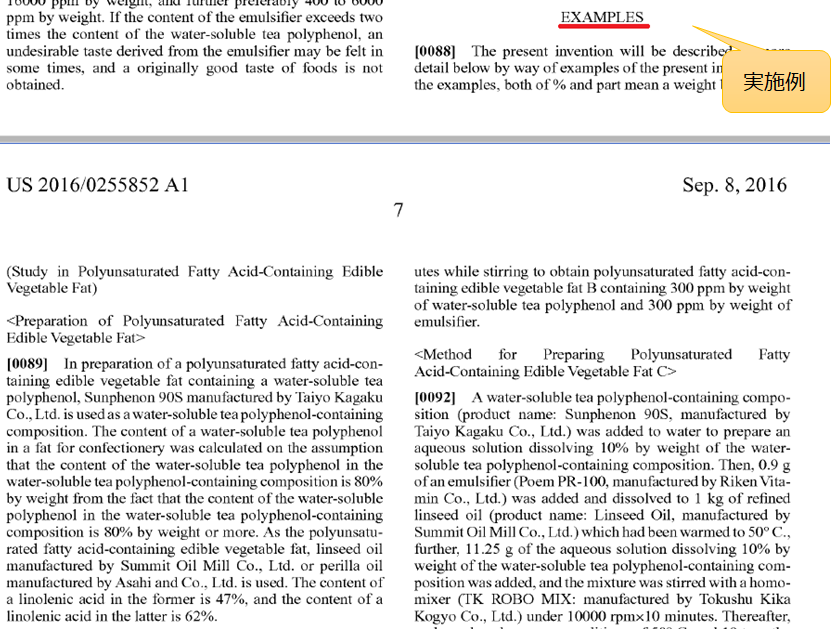
However, there are not many cases in which the gazettes written by foreign applicants bother to set items for "problems," "effects," and "examples."


Many foreign gazettes (especially gazettes written by foreign applicants) say that "the problems, solutions, effects, and examples are all written together without even being divided into items", and "where and what is written". It seems that "it is hard to understand if there is one" is the cause of many people who feel that "foreign publications are hard to read".
XNUMX. XNUMX.Reading techniques for foreign patent gazettes
When reading a "difficult to understand where and what is written" gazette written by such a "foreign applicant", how should I "understand the contents of the gazette"?
To understand the contents of the gazette, as mentioned above, in order to "(XNUMX) solve" "(XNUMX) some problems / problems" that existed in "(XNUMX) conventional technology", "(XNUMX) developed the method used this time. It is to grasp the flow.In other words, if you can consistently read what kind of technical field, what kind of problem the conventional technology has, and what kind of means was used to solve the problem, "The contents of the publication I understand it all. "Let's take a look at some tips for reading the above.
XNUMX-XNUMX Keywords for finding the location of each item
There are keywords that are often used at each stage of "(XNUMX) conventional technology," "(XNUMX) problems," "(XNUMX) method (means) invented this time," and "(XNUMX) solution (effect of invention)."By reading around this keyword, you can roughly understand each item and get a general idea of the flow.Here, an English publication is taken as an example.
For example, in "② Problem", "where was the problem caused by using the conventional technology?" Is a topic, so in English, "problem", "disadvantage", "drawback", "desire", etc. Words related to "points" and "defects", the conjunctive conjunction "However" to say "I have this kind of technology, but ..." about the technology so far, and the word "The object of this invention ..." , Etc. are used.
In the case of "④ solution (effect of invention)", words related to "effect" such as "improving" and "advantage", or "The effect of this invention" may be written straight.
In addition, there are places where the content of each item appears frequently.For example, "(XNUMX) conventional technology" and "(XNUMX) problem" are related to "background that led to this invention", so they are often written in "background art", and "(XNUMX) method (means) invented this time). Is the main topic of the gazette, so the outline is often written in the "claims" and the "summary" part of the text. Regarding "④ Solution (effect of the invention)", if there is an example, it is shown in the part where "effect measurement" and "evaluation" are performed in the example, or in a sentence hidden in the text. It is often written, but since there is no such thing as "If you look here, it seems that it is definitely written", it can be difficult to find a description of the effect.
XNUMX-XNUMX Example
As an example, let's assume that you want to understand the overall contents of the document "US2018 / 0295853" on "How to refine cocoa powder from cacao". (J-PlatPat is used here.)
As a test, highlight the keyword "problem" related to "② Problem".
(* Highlights use browser functions)
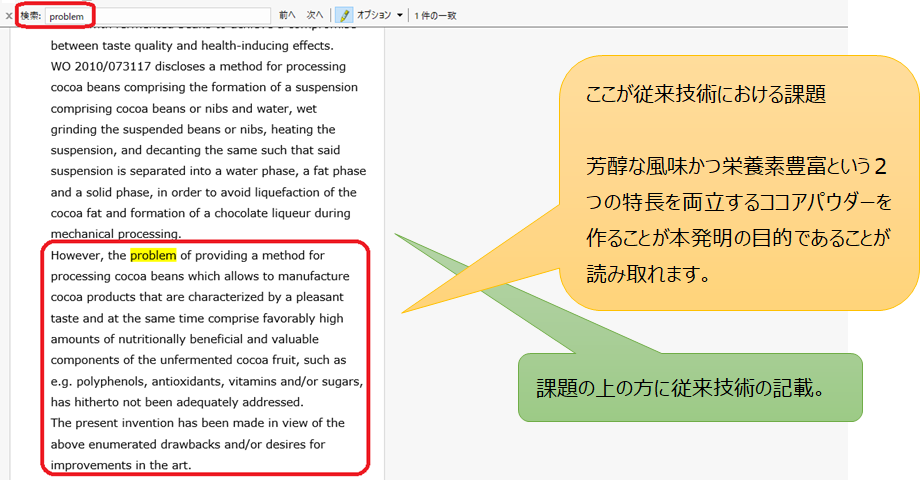
An example of "(XNUMX) conventional technology" is described in the part surrounded by the red frame (paragraph immediately before the keyword related to "(XNUMX) problem").
WO 2010/073117 comprising a method for processing cocoa beans comprising the formation of a suspension comprising cocoa beans or nibs and water, wet grinding the suspended beans or nibs, heating the suspension, and decanting the same such that said suspension is separated into a water phase, a fat phase and a solid phase, in order to avoid liquefaction of the cocoa fat and formation of a chocolate liqueur during mechanical processing.
US2018 / 0295853 (ODC Lizenz AG (CH))
(A method of crushing cocoa beans or cocoa nibs in water and heating to separate the water-soluble part, the oil-soluble part and the solid)
In the paragraph following "(XNUMX) Conventional Technology" (the part surrounded by the red frame above), "(XNUMX) Issues" is described.
However, the problem of providing a method for processing cocoa beans which allows to manufacture cocoa products that are characterized by a pleasant taste and at the same time encapsulate favorably high amounts of nutritionally beneficial and valuable components of the unfermented cocoa fruit, such as eg polyphenols , antioxidants, vitamins and / or sugars, has hitherto not been adequately addressed.
US2018 / 0295853 (ODC Lizenz AG (CH))
(Until now, a method for making cocoa powder that has both the two characteristics of mellow flavor and nutrient richness has not been fully developed.)
Then, in order to search for "③ the method invented this time" (to solve "② problem" of "(XNUMX) prior art"), check "Summary" in the claim and the text.

A method for processing unfermented cocoa beans, comprising the steps of:
US2018 / 0295853 (ODC Lizenz AG (CH))
(a) adding water to said unfermented cocoa beans with or without cocoa pulp and mucilage to form a suspension;
(b) wet grinding said suspension;
(c) subjecting said suspension to a heat treatment at a temperature of 70 ° C. or less;
(d) separating the suspension into a water phase (heavy phase), a fat phase (light phase) and a solid phase, said fat phase comprising cocoa butter as a major component and solids and / or water as minor components and said solid phase comprising cocoa powder and water; and
(e) separately processing the three phases, which optionally:
separating cocoa butter from the fat phase,
separating cocoa powder from the solid phase, and
separating cocoa aroma and a polyphenolic powder from at least the water phase.
((A) Add water to cocoa beans, (b) Grind in water, (c) Heat at 70 ° C or lower, (d) Separate into aqueous phase, oil phase and solid phase, (e) ) Process of processing each of the three separated parts)
For "② Problem" (method of making cocoa powder), the method of processing cocoa beans into powder is described as it is in the description of the claim, and this is considered to correspond to this "solution". I will.
Furthermore, if you take a look at the summary (SUMMERY OF THE tetrahydrofuran) in the text, you will find an outline of the manufacturing method for cocoa bean powder, which is considered to be the key to this invention. I will.
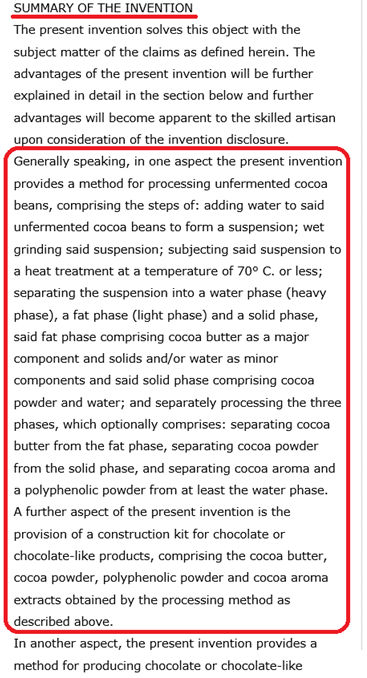
Generally speaking, in one aspect the present invention provides a method for processing unfermented cocoa beans, comprising the steps of: adding water to said unfermented cocoa beans to form a suspension; wet grinding said suspension; subjecting said suspension to a heat treatment at a temperature of 70 ° C. or less; separating the suspension into a water phase (heavy phase), a fat phase (light phase) and a solid phase, said fat phase comprising cocoa butter as a major component and solids and / or water as minor components and said solid phase comprising cocoa powder and water; and separately processing the three phases, which optionally: separating cocoa butter from the fat phase, separating cocoa powder from the solid phase, and separating cocoa aroma and a polyphenolic powder from at least the water phase.
US2018 / 0295853 (ODC Lizenz AG (CH))
(Almost the same as claim XNUMX is described)
Next, highlight the phrase "advantage" in order to search for "④ solution (effect of the invention)".
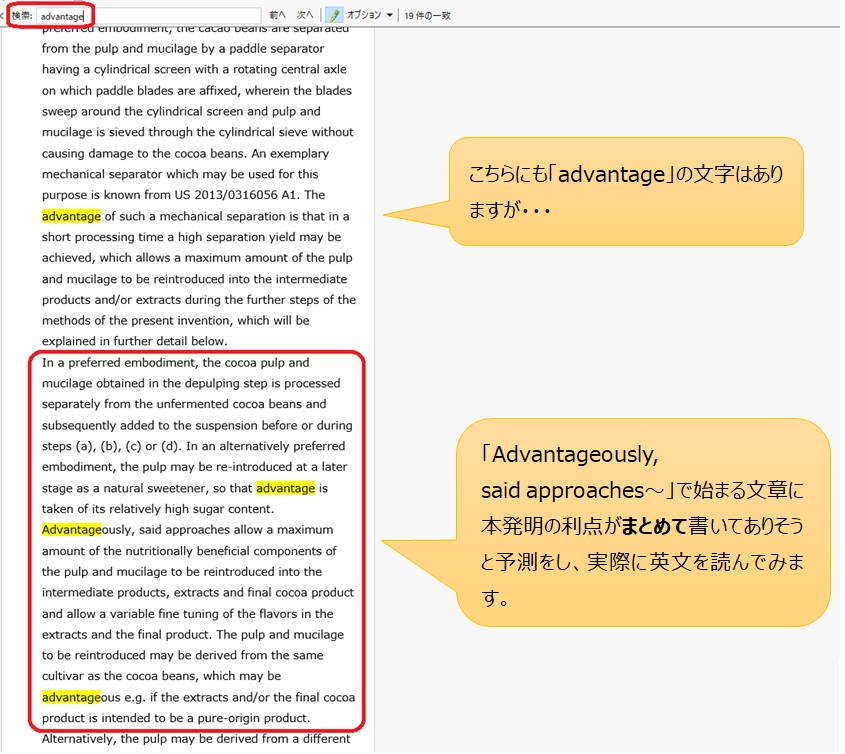
The phrase "advantage" appears in several places, so when you actually read it, this red frame is the challenge of "creating cocoa powder that has both mellow flavor and abundant nutrients." Matches.
In a preferred embodiment, the cocoa pulp and mucilage obtained in the depulping step is processed separately from the unfermented cocoa beans and subsequently added to the suspension before or during steps (a), (b), (c) or (d). An intermediate preferred embodiment, the pulp may be re-introduced at a later stage as a natural sweetener, so that advantage is taken of its relatively high sugar content. Advantageously, said approaches allow a maximum amount of the nutritionally beneficial components of the pulp and mucilage to be reintroduced into the intermediate products, extracts and final cocoa product and allow a variable fine tuning of the flavors in the extracts and the final product. The pulp and mucilage to be reintroduced may be derived from the same cultivar as the cocoa beans, which may be suspended eg if the extracts and / or the final cocoa product is intended to be a pure-origin product.
US2018 / 0295853 (ODC Lizenz AG (CH))
(The pulp portion and mucilage obtained in the cocoa bean de-pulping step can be treated separately from the cocoa beans, and the pulp portion and the like can be added at any stage of the treatment steps (a) to (d). In particular, adding pulp or the like in the latter stage of the treatment process increases the flavor and sugar content.)
To summarize the above, there is a problem in the method of "making cocoa powder that has both rich flavor and nutrient richness", and by using the method described in the claim or summary, the flavor is strong and sugar. It can be read that the gist of the present invention is to produce cocoa powder having a high content of.
XNUMX.in conclusion
Foreign literature can be awkward, especially for those who are not accustomed to reading it.However, it is a little easier to read psychologically and physically by keeping "what information you want to know" and "where to look to know it" in the corner of your head. Isn't it?Although I didn't mention it this time, there are translation sites that help you read foreign literature, so I think that you will be able to read the publications easily by actively using what you can use and reducing the burden as much as possible.
Research Division Kudo
【reference】
・ J-PlatPat (Reference date: November 2019, 11)
https://www.j-platpat.inpit.go.jp/p0000
Inquiry
For inquiries regarding IP research and inquiries about our business, please contact us.
Please feel free to contact us using this form.